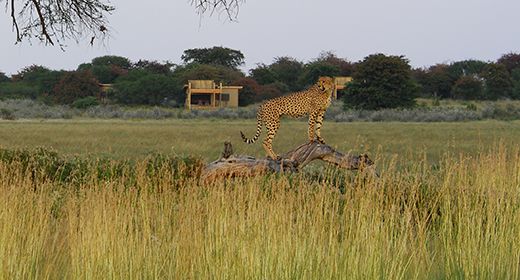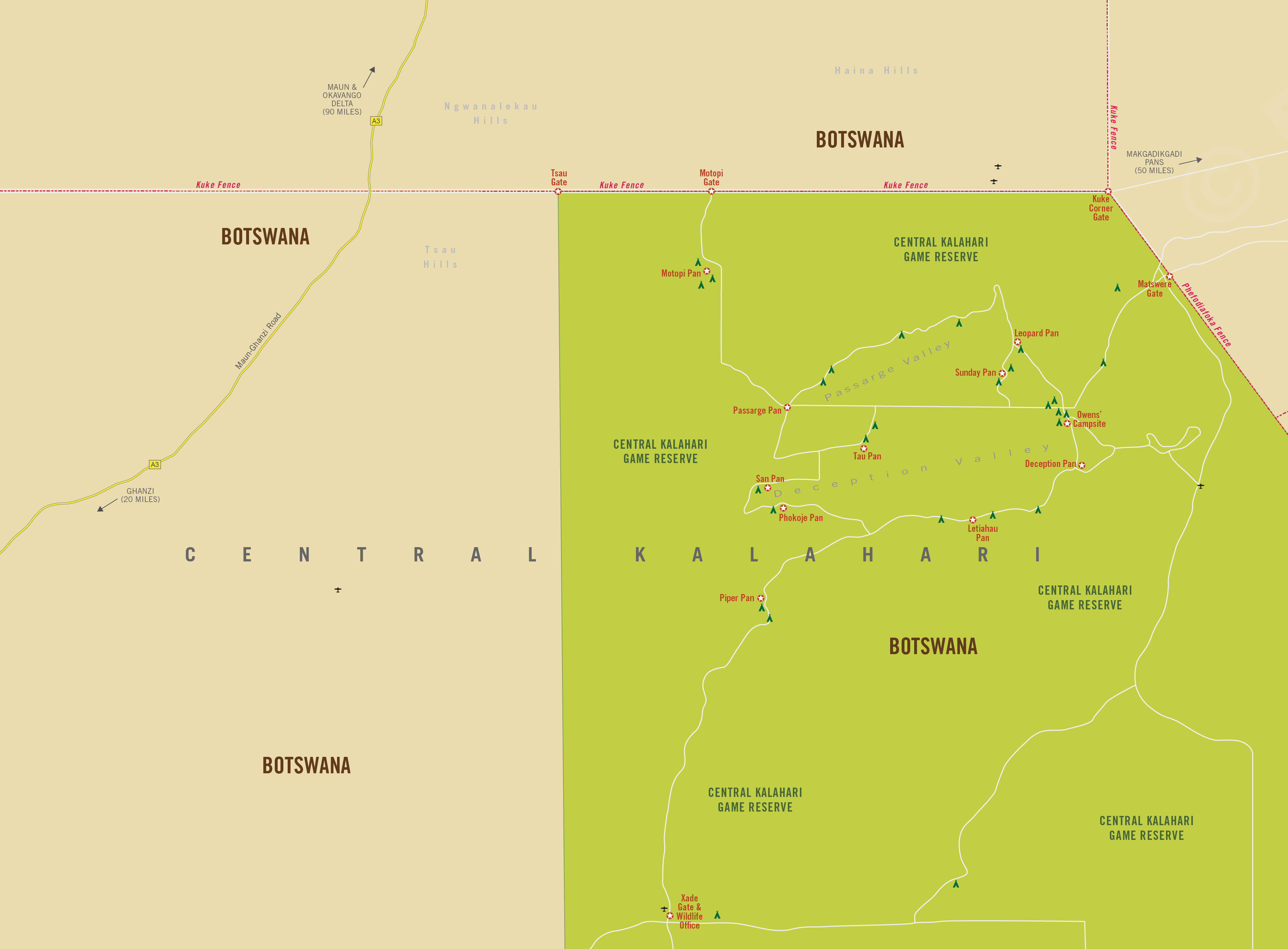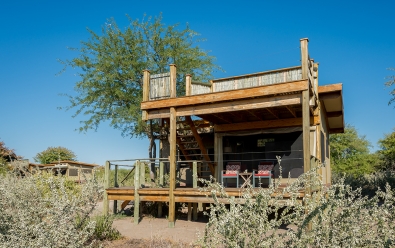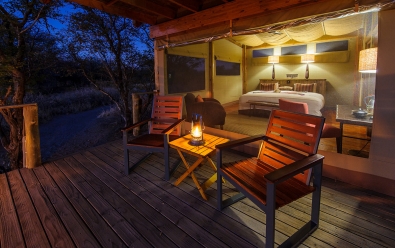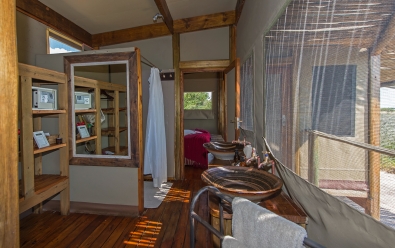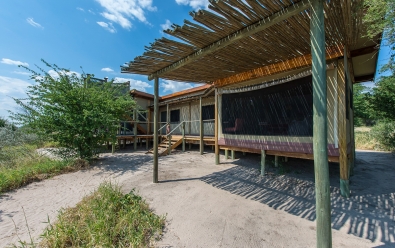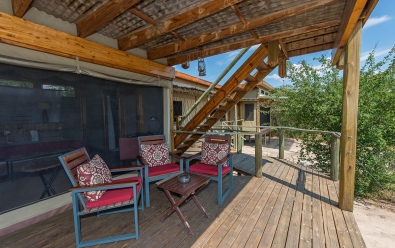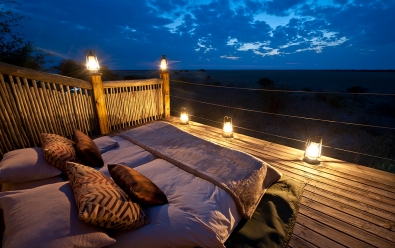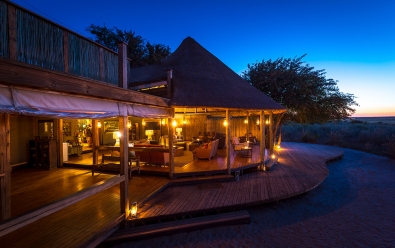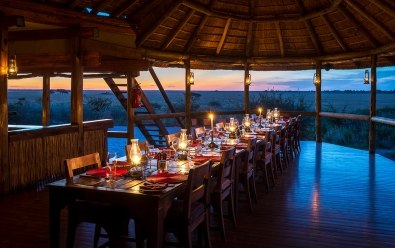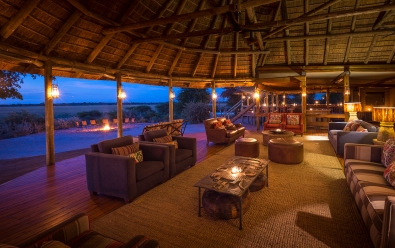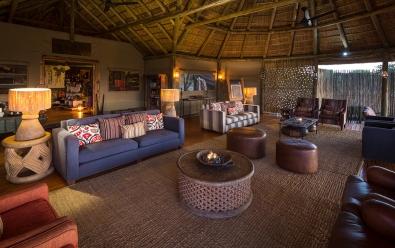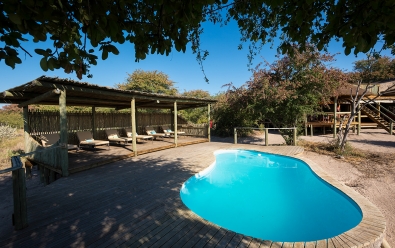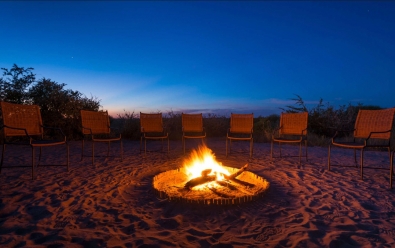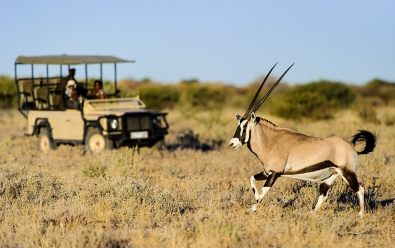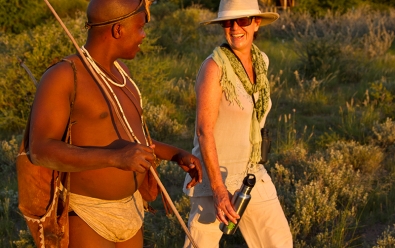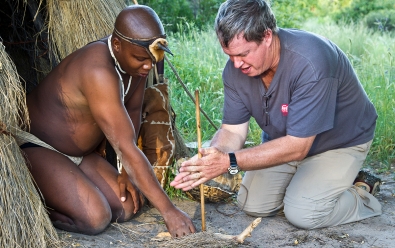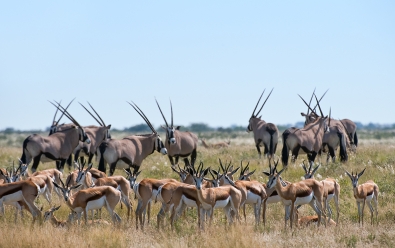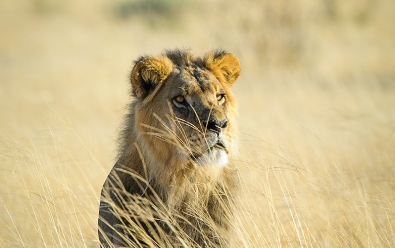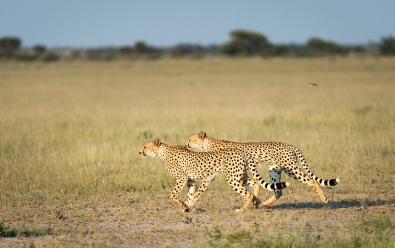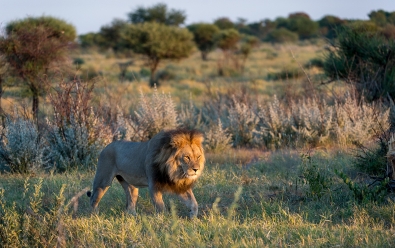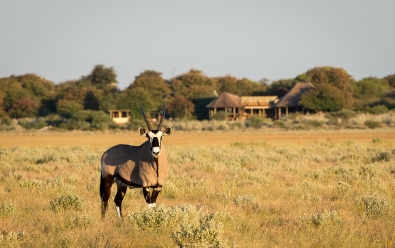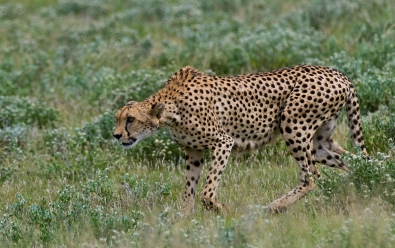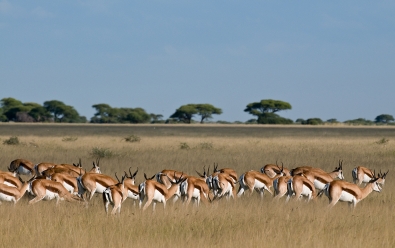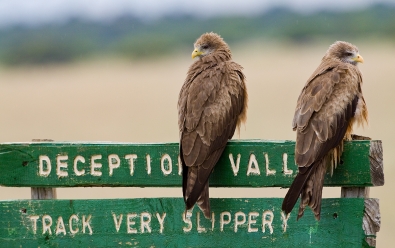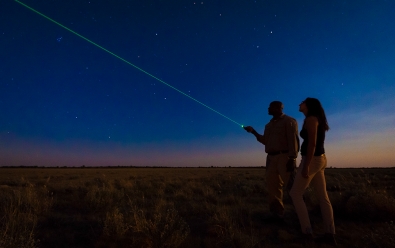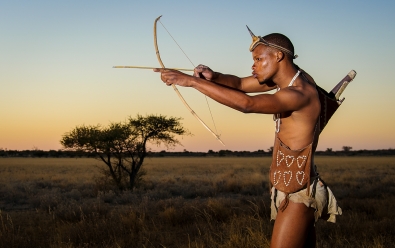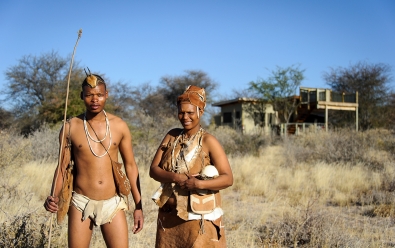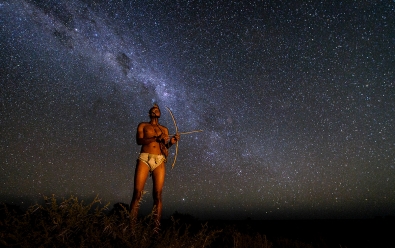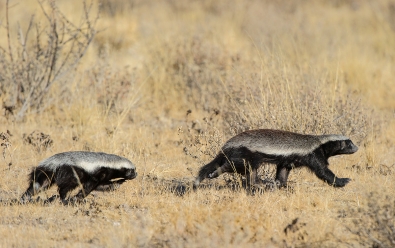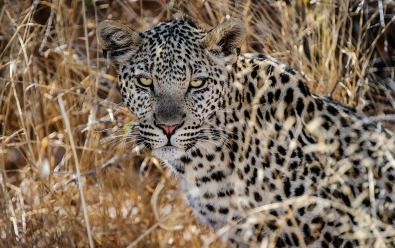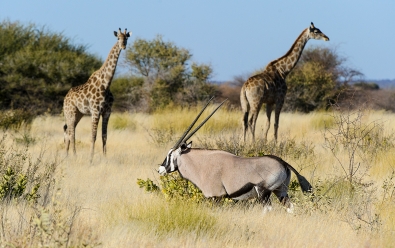Kalahari Plains Camp
Inquire for lodging prices
Highlights
- Superb summertime wildlife viewing (during the desert rains)
- Game-viewing drives and cultural activities with San bushmen people
- One of the best places to see cheetah in southern Africa
- Easily combined with a safari in the Okavango Delta
Location
- Central Kalahari Game Reserve (Northern)
- Kalahari Desert
- Central Botswana
Kalahari Plains Camp is located in central Botswana's Kalahari Desert and offers some of the best summertime wildlife viewing in southern Africa.
The camp is situated in the remote Central Kalahari Game Reserve (CKGR), a vast protected area covering 20 400 square miles (52 800 sq kms) and Botswana's largest conservation area. The camp offers game drives to explore the semi-desert ecosystem, as well as cultural interactions with the indigenous San (bushmen) people, a hunter-gatherer tribe that have lived here for centuries.
Wildlife viewing is at its peak during the summer green season (between December and April), when local rainfall transforms the otherwise dry desert landscape into a green grassland, attracting large numbers of herbivores that arrive to feast on the nutrient-rich grasses and other vegetation. The short grasses are particularly rich in the northern part of the reserve (where the camp is located), where fossil riverbeds and a system of rain pans provide for excellent conditions for grazers.
Wildlife commonly seen during the rainy season includes large herds of springbok and good numbers of oryx (gemsbok), red hartebeest, and blue wildebeest. The large number of herbivores present here at this time attracts plenty of predators, particularly cheetah, which do very well in the flat open plains, where they can chase down springboks. Other predators seen regularly include lion, leopard, and black-backed jackal.
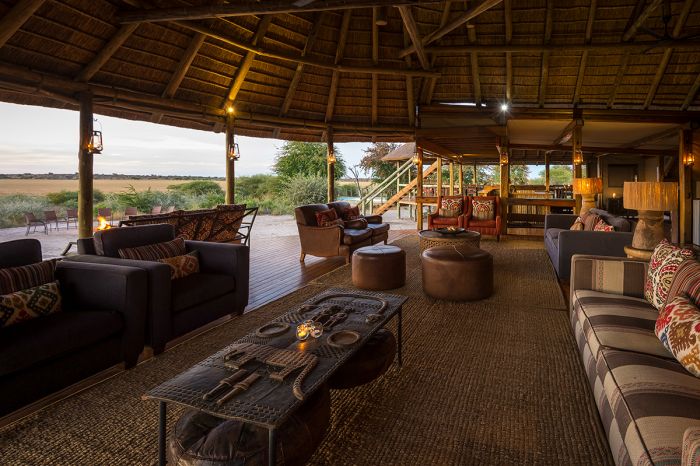
Main area lounge and view.
Kalahari Plains is located in the prime wildlife viewing area in the northern section of the reserve. A favorite activity is a full-day trip to Deception Valley, an ancient riverbed which today is an 50-mile-long (80-km) gentle valley floor covered with short palatable grasses, interspersed with picturesque tree islands. The name 'Deception' is derived from the mirage effect caused by the dry surface of the pan halfway along its length, which often appears misleadingly full of water.
Mark and Delia Owens lived and conducted research on wildlife in the CKGR for seven years during the 1970s (before the reserve was opened for tourism) and their campsite was based in Deception Valley. The Owens' best-selling book Cry of the Kalahari (highly recommended) is based on their experiences during that time.
Kalahari Plains Camp is one of just two permanent accommodations located in the reserve (there are also numerous camping sites that are used by overland camping operators and self-campers). The camp offers 8 spacious tented guest units, one of which is a double/family unit. The guest rooms are made of canvas and wood atop elevated wooden decking and connected to the main camp area by sandy footpaths. Each room also has a rooftop sleep-out deck with a bed.
The main dining, lounge, and pool area are raised to allow viewing across the grassland in front of camp.
Wilderness Safaris are one of Africa's leading safari operators and they strive to minimize energy consumption at all their camps. Kalahari Plains Camp is powered by a hybrid system, which combines solar power and a diesel-powered generator. Strict eco-friendly environmental standards are maintained so that no harmful chemicals or waste is allowed to enter the pristine ecosystem of the Kalahari.
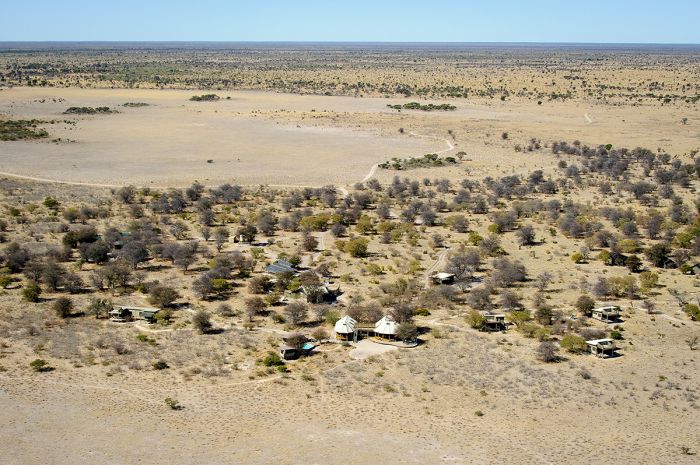
Aerial view of Kalahari Plains Camp.
About the Kalahari
Located in the western-central part of Botswana, the Kalahari Desert covers some 350 000 square miles (900 000 kms), including much of northern and western Botswana and significant parts of eastern Namibia and northwest South Africa. Smaller parts of the Kalahari extend into Angola, Zambia, and Zimbabwe.
The Kalahari is a semi-desert, which differs from a true desert in that it receives more rain and thus has more ground cover vegetation and more trees. The result is an arid region that supports good numbers of wildlife, especially during and after the rains.
Botswana occupies by far the greatest portion of the Kalahari, and the landscape here is dominated by open plains, sand that varies in color between yellow and red, salt pans (the largest of which is the Makgadikgadi Pans), and fossilized river beds (the Kalahari region was historically much wetter and cooler, at least from 30 to 11 thousand years ago).
The wildlife-rich Okavango Delta in northern Botswana is in fact part of the Kalahari, but it has been transformed into a paradise for animals due to rivers from the north bringing fresh water and sediments into Botswana, where is spills into a shallow and flat trough in the sands between fault lines, creating a fan-shaped network of islands and waterways that forms the shape of a massive river delta.
The name Kalahari is derived from the Tswana word 'kgala', which means 'thirst' (Tswana is the native language spoken in most of Botswana).
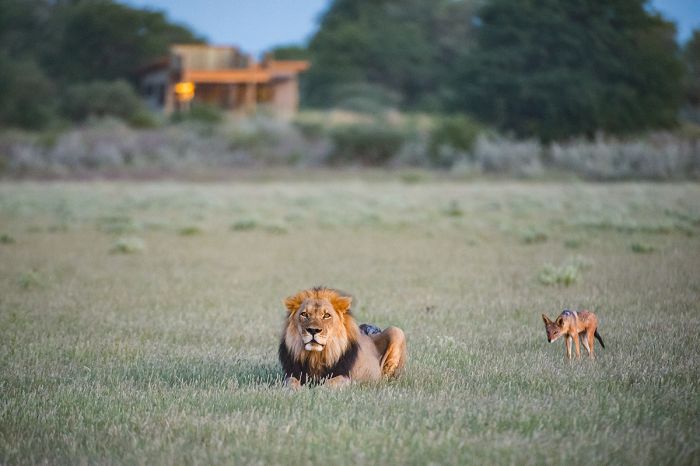
A lovely male Kalahari lion in front of the camp.
Central Kalahari Game Reserve (CKGR)
Botswana has protected a large portion of the Kalahari Desert in various reserves, including the Makgadikgadi National Park, the Moremi Game Reserve (part of the Okavango Delta), Chobe National Park, and the Central Kalahari Game Reserve (CKGR).
The reserve was declared in 1961 to protect the indigenous San (or bushmen), a hunter-gatherer people that were once found throughout much of southern Africa, but were pushed out into marginalized areas by the arrival of Bantu tribes from the north long ago. The Kalahari became their home and they have eked out an existence here in small numbers for centuries.
The reserve was originally closed to the public for around 30 years. In the early 1990s, the CKGR was opened for tourism, which for many years consisted solely of overland self-campers and organized safari trips originating out of Maun, Botswana.
Today, there are a good number of camping sites located along a sandy track road circuit that visits the various waterholes surrounding Deception Valley and Passarge Valley. There are also two permanent safari camps in the CKGR that offer fully-inclusive safaris to their guests.
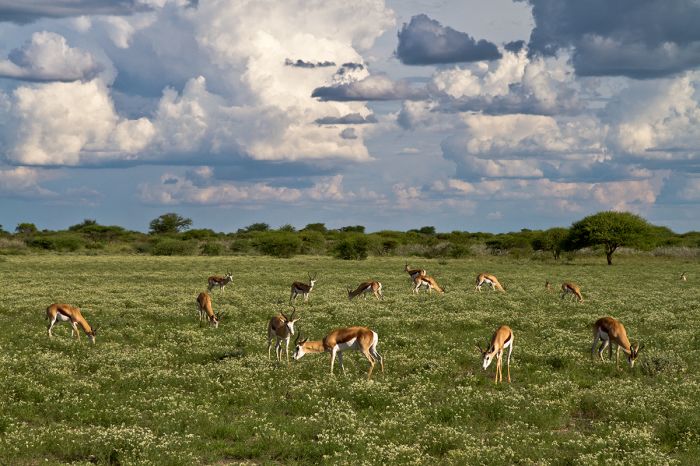
Springboks in the fresh summertime grass, Central Kalahari Game Reserve.
The CKGR covers a vast area in the western/central part of Botswana, spanning 20 400 square miles (52 800 sq kms), making it one of the largest game reserves in the world. The northern part of the reserve, particularly the area around two fossilized river valleys - Deception Valley and Passarge Valley, becomes a haven for wildlife once the rains begin (usually in mid-December). Visiting this unique ecosystem from that December until April is a very special experience for wildlife and nature lovers.
Wildlife in the CKGR includes species that are tolerant of semi-desert conditions. Springbok are the most common large mammal and are found throughout the reserve all year. Other herbivores that are likely to be seen, particularly during the green season include blue wildebeest, oryx, red hartebeest, eland, greater kudu, giraffe, steenbok, common duiker, and Cape ground squirrel.
Predators that may be seen include lion, cheetah, leopard, brown hyena, black-backed jackal, Cape fox, bat-eared fox, aardwolf, caracal, honey badger, meerkat, yellow mongoose, and African wild cat. African wild dogs are seen on occasion.
Bird life includes many desert-adapted species, with likely species including ostrich, secretarybird, and northern black korhaan. Raptors are present in good numbers and include yellow-billed kite, pale-chanting goshawk, and a variety of eagles and falcons. Over 220 species of birds have been recorded in the CKGR.
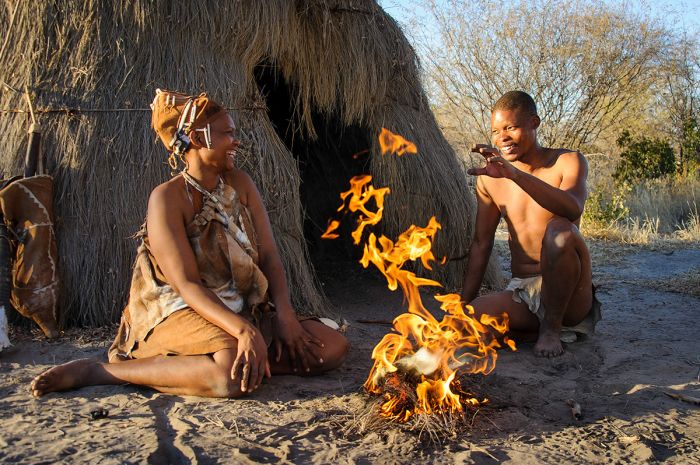
The indigenous San (bushmen) people still live in the CKGR.
ROOMS INCLUDES & EXCLUDES CHILDREN FACILITIES ACTIVITIES
Accommodation
8 guest accommodations in total comprising:
- 7 twin-bedded canvas tented rooms, each with two three-quarter beds. Mattress converters are available that transform twin beds into a double beds (to be arranged prior to arrival).
- 1 family unit consisting of two separate tented bedrooms, each with two three-quarter beds (sleeping four in total) and each with its own en-suite facilities. The main bedroom has a rooftop deck. The main bathroom and second bathroom each have an indoor shower, double-basin vanity, and separate toilet. The two units each have a separate entrance and separate lounge area, but share an outdoor deck with a seating area. The family unit can accommodate 2 adults and 2 children.
Each canvas-tented accommodation is constructed atop a raised wooden deck with views of surrounding grassland. En-suite facilities include an indoor shower, a double-vanity basin, and separate toilet. Due to desert the location, the water in the shower has a high salt content. To combat the desert conditions, the canvas walls and roofs have been specially insulated to keep out most of the heat during the day and the cold during the night.
The units are connected to the main camp area by sand pathways on the ground.
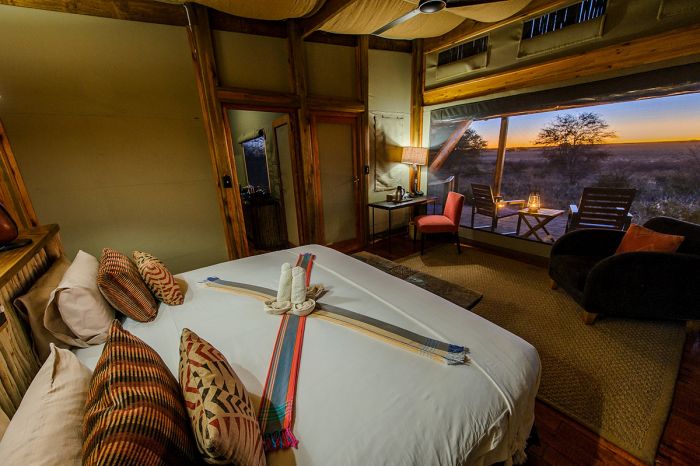
Guest tent interior and view.
Guest room amenities include a writing desk and chair, easy chairs, a veranda with seating, multi-plug charging facilities, and mosquito netting for the beds. Hot water bottles and extra blankets are provided during the chilly winter months.
Other items and features in the guest units include:
- Private rooftop area for sleep-outs accessed by stairs from the tent deck (two mattresses and solar lights provided. Sleep outs are weather permitting and operated subject to the discretion of the Camp Manager.
- Electronic safe.
- Tea and coffee making facilities.
- Hairdryer.
- Ceiling fan and pedestal mist fan.
- Yoga mat.
- Free weights (2x 1-kg and 2x 2-kg) and resistance bands.
- In-tent Wi-Fi.
- Personal amenities, including seasonal bathrobes, slippers, liquid soap, body wash, shampoo and conditioner, body lotion, room spray, insect repellent, insect spray, mosquito coil, shower caps, vanity kit with cotton-tip swabs, cotton wool pads, sewing kit, tissue dispenser, laundry bag, and umbrella.
Kalahari Plains Camp can accommodate a maximum of 18 guests in total: 2 adults and 2 children in the family room and 2 persons in each of the other 7 tented rooms.
Includes & Excludes
Includes:
- All meals and local beverages including wines, spirits and liqueurs, but excluding premium imported brands and Champagne.
- Twice-daily safari drives in open game-viewing vehicles and other scheduled camp activities (accompanied by experienced guides).
- In-camp laundry facilities for guests is not available at Kalahari Plains due to the scarcity of water. Laundry for the camp (linen, towels, uniforms, etc.) is handled off-site in Maun.
- Wi-Fi access.
- Tourism Levy & VAT.
Excludes:
- Purchases from the Safari Trading Store.
- Premium imported beverages and Champagne.
- Any applicable wildlife fee, park fee, reserve fee, concession fee, other land-use fee.
Single Supplement
A single supplement will apply for any room booked by a single traveler; please ask us for pricing.
Children
Children aged 6 years and older are accommodated at Kalahari Plains:
- For families traveling with children between 6 and 12 years, private activities must be booked and paid for.
- Children between 6 and 16 years must share with an adult/s in the same room.
- The minimum age for walking activities is 13 years (subject to season and the availability of a qualified walking guide).
- The minimum age for sleep-outs is 13 years.
Facilities
Main guest area facilities include:
- Pool in main area with partially shaded deck and loungers.
- Lounge/dining and bar areas under thatch with a surrounding wooden deck (all with drop down blinds and ceiling fans).
- Elevated viewing deck above the main area for al fresco dining and stargazing.
- Waterhole in front of camp.
- A pair of Olympus binoculars in the main area.
- Campfire area.
- During winter months knee blankets are provided during dinner.
- Spotting scope.
- Safari Trading Store.
- Guest toilet in main area.
Activities
Activities included in the rate:
- Daytime game drives and early evening game drives only (no night drives, but driving is allowed an hour before and an hour after park closure) in 4x 10-seater open 4x4 Land Cruisers. To allow for comfort and space, the policy is no more than 6-7 guests per vehicle.
- During winter months hot water bottles (on early morning game drives only), blankets, and lined ponchos are provided.
- The camp has a supply of bean bags for guests to use to steady their cameras while on a game drive.
- A pair of Olympus binoculars is available in each of the game drive vehicles for guests to share amongst themselves while game viewing and may be requested from our guides.
- Full-day excursion to Deception Valley with a picnic brunch (only possible on a minimum 3 night stay or more). For a stay of 2 nights, a private vehicle needs to be booked and paid for.
- Guided, interpretative walk with the indigenous San (bushmen) people, led by camp staff members who are descendants of the original San.
- Guided nature walks (seasonal and subject to the availability of a qualified walking guide). Maximum of 6 guests per walk, with additional guests being possible on the proviso that a second qualified walking guide is accompanying the same walk. Approximate duration 1.5 hours, departing camp just before sunrise and walking to one of the pans in the area.
- Birding.
- Private rooftop area for sleep-outs accessed by stairs from guest tent deck. Two mattresses and solar lights provided. Weather permitting and operated subject to the discretion of the Camp Manager. Maximum of 02 guests.
- Stargazing with a laser pointer.
Optional activities at additional cost:
- Private activities are on offer (subject to vehicle availability which needs to be booked in advance).
Example of a typical day:
- Early morning wake-up call. Morning wake-up and activity times vary according to the seasons, activities on offer, and wildlife sightings.
- Light breakfast before departing on the morning activity.
- Return to camp for a meal and rest period.
- Meet for afternoon tea and snacks (savory and sweet choices) before departing on the activity.
- Return to camp - freshen up or meet for drinks, followed by dinner.
- Enjoy a nightcap or discussion around the fire before retiring.
Great Good Fair Poor
- Jan
- Feb
- Mar
- Apr
- May
- Jun
- Jul
- Aug
- Sep
- Oct
- Nov
- Dec
Green Season
Contrary to most wildlife destinations in Africa, the best time to visit the Central Kalahari is during the rainy season. This is because the Kalahari is a semi-desert and fresh grazing explodes during and for a time after the rains have abated, attracting large numbers of herbivores to the region.
The substantial rains in the Central Kalahari Game Reserve (CKGR) typically begin falling in mid-December and continue into mid- or late-April. During this time, the grasses and other ground cover come to life, transforming the arid landscape into a verdant ecosystem ripe with sustenance for the herds of springbok, oryx, red hartebeest, and blue wildebeest, which come to the northern part of the reserve to feed on the fresh vegetation.
The wildlife viewing at this time is outstanding, not to mention the photo and video opportunities, with fabulous colors on the ground and dramatic skies. Depending on the timing of the rains, the excellent game viewing can continue well into May.
The green season temperatures are warm throughout the day, with comfortable mornings, but reaching 90°F (32°C) or higher in the afternoons. The build-up of heat usually means daily afternoon thunderstorms, which bring relief to the warm air.
The earliest part of the season (November and December) is mostly sunny, with only the occasional downpour, but January and February experience afternoon rains almost every day. The rains usually last a few hours at most. By March, the daily rains have diminished, with showers occurring only every few days and the temperatures also become slightly cooler.
The green season is by far the best time to visit and this is high season in the Kalahari, but the reserve is never crowded per se. There are only a couple permanent safari camps and the rest of the visitors are self-campers or on organized overland trips staying at one of the various camping sites.
Dry Season
The heart of the dry season in the Kalahari is June through October and at this time, the vegetation has become dried and the ground parched. The herds of springbok and other herbivores disperse from the rich grasslands of the north to look for available grazing along the various fossilized riverbeds found further afield.
Although the dry months are a far cry from the excellent game viewing that is possible during the rains, there are waterholes along the road circuit in the northern part of the reserve (where the permanent camps and self-camping sites are located) that remain productive through the dry season. Two of the waterholes (Letiahu Pan and Piper Pans) have borehole pumps that supply fresh water all year to the resident wildlife and these spots can be good for game viewing at this time.
The rains generally end sometime during April and the reserve gradually becomes drier by the day. April and May are mainly sunny every day, with midday temps averaging around 82°F (28°C). June and July are winter and experience the coolest temperatures, with afternoons averaging around 75°F (24°C). Typical of a desert, early morning temps in the winter are chilly to cold, averaging 43°F (6°C).
September and October are the final months of the dry season and October is typically extremely warm, with afternoon temps reaching 93°F (34°C) or higher, but with comfortable mornings and nights.




